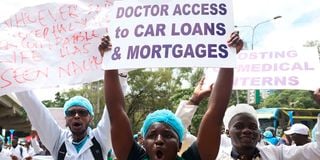Health sector management requires a paradigm shift

Striking doctors in a procession along Uhuru Highway in Nairobi on April 9, 2024.
What you need to know:
- Kenya allocates about 11 per cent of its national budget to the health sector.
- The internship programme is critical in shoring up the provision of health services.
The public health sector is currently dysfunctional due to a standoff between the government and doctors.
The situation in public health facilities has been characterised by anguish and desperation, with hundreds of deaths already reported over the last four weeks.
The doctors have refused to cede any ground despite the carrot-and-stick games that the government has been playing since the beginning of this industrial action.
Kenya is in a serious deficit of doctors.
To achieve the Sustainable Development Goals, the World Health Organization (WHO) recommends a doctor-to-population ratio of 1:1000.
With a ratio of 19:100,000 (2022), Kenya lags far behind the WHO recommendation, with dire ramifications.
A comparison of Kenya and Cuba should suffice for this analysis.
Cuba allocates about 23 per cent of its national budget to the health sector. On the other hand, Kenya's allocation to the sector is about 11 per cent.
The Caribbean country has prioritised the training and deployment of doctors to deepen the provision of health services to the population. As a result, the country has achieved a doctor-to-population ratio of 1:8.4.
Shortage of doctors
The country has also managed to significantly bring down the maternal mortality rate to 113 per 100,000, and infant mortality is now down at 4.188 per 1000 live births. The comparable figures for Kenya are 414 and 31.771, respectively.
The significance of doctors in a country can, therefore, not be gainsaid.
Given the shortage of doctors in the country, the internship programme is, therefore, critical in shoring up the provision of health services.
The current policy views intern doctors as typical students on training while blatantly ignoring the fact that they actually perform doctor's duties under the supervision of their superiors. This thinking in government is highly detestable.
That being the case, several issues arise concerning the internship programme for doctors.
First, the programme was developed at a time when the only institution that was training doctors in the country was the University of Nairobi.
The government could forecast and budget for the small number of doctors graduating from the institution each year.
Currently, many public and private universities train doctors in Kenya. In addition, some are trained abroad.
Although the country is in dire need of more doctors, there is an obvious budgetary challenge concerning the indeterminate number of doctors graduating from universities every year.
Internship programme
Given the legitimate expectation that the government should respect its policy pronouncements, such commitments mustn't be made based on information asymmetry.
Because of the foregoing, the government needs to either regulate the numbers or invite the private sector, as a key employer of doctors, to participate in developing a robust framework for the internship programme.
It should be expected that once the internship programme has been streamlined, complete with new and better terms and conditions of service, there should be marked improvement in health service delivery.
Sadly, this is unlikely to be the case until the government stocks the health facilities with the necessary drugs and equipment, and doctors start living in the rural communities where their services are most needed.
Equally critical is the balance between preventive and curative care. Current health literature advises that a developing country such as Kenya requires more preventive care than curative treatment.
Preventive care has tremendous dividends as opposed to curative care which is capital intensive, but the success rates are relatively lower. The exorbitant medical costs do not make things any better for Kenyans.
Oftentimes, Kenyans get to hospital in critical conditions when the doctors cannot help them. In fact, most Kenyans are only one disease away from bankruptcy.
The dysfunction of the public health system in Kenya has created a gap for private health providers to fleece patients.
That is why India, with a working public health management model, has become an attractive medical tourism destination for lots of Kenyans in the last two decades or so.
Remuneration of doctors
Kenya has very few doctors in the rural villages. It has been argued that the most effective strategy for delivering preventive health care in the Kenyan context is to train more nurses and clinicians and deploy them to the rural villages which are more vulnerable to communicable diseases.
A clear career path should then be created for these cadres of health workers to incrementally acquire basic skills in medicine to enable them to intervene in less complex situations where doctors are not available.
This approach has worked very well in the USA, Europe and other places where nurses have a defined path for progressing to become practitioners and doctors, and effectively availed more health services to the rural communities.
Cuba has successfully implemented the policy of deploying doctors to rural villages, with quite impressive results.
For Kenya to achieve the envisaged health-related SDGs, doctors must be willing to serve among the rural communities, and support primary health care at the grassroots.
The issue of remuneration of doctors must also be addressed comprehensively along with those of other public servants.
Unfortunately, Kenya has chosen the path of negotiating remunerations for public sector employees with labour unions instead of adopting scientific approaches that are now in vogue across the globe.
Labour unions tend to be vicious and selfish in negotiating for their members, and often ignore the economic realities of the country.
Universal healthcare
For instance, Kenya is currently not in a very comfortable economic situation. To push the economy to absorb more wages at the moment, especially when the revenue side is not showing positive signs, is not sustainable, and may be a recipe for further borrowing.
But there is a catch. The Auditor General has reported numerous cases of unrelenting sleaze in the public sector.
If only public servants could reduce their appetite for pilferage by about 30 per cent, the government would be in a position to meet all its budgetary obligations and much more from domestically generated resources.
The country would then be able to comfortably meet the demands of the doctors.
For now, someone in government should be brave enough to tell the striking doctors that some of their demands may be met for now, but in the long run, they will be unsustainable and may end up hurting the health sector and the economy at large.
Once that point is made very clear to all the stakeholders in the health sector, then they should embark on developing a framework that is not only realistic but sustainable.
My position on this matter is that the government should provide a list of all health facilities, both private and public, where graduating doctors can go for internship. While they are there, their pay should be negotiated between themselves and the facility.
The ones who are absorbed into government health facilities should be paid an amount based on a model developed and agreed upon by all key stakeholders.
Priority should be given to doctors who are willing to work in the rural areas to help the government to achieve its objective of universal healthcare by 2030.
Prof Ongore teaches at the Technical University of Kenya; [email protected]





